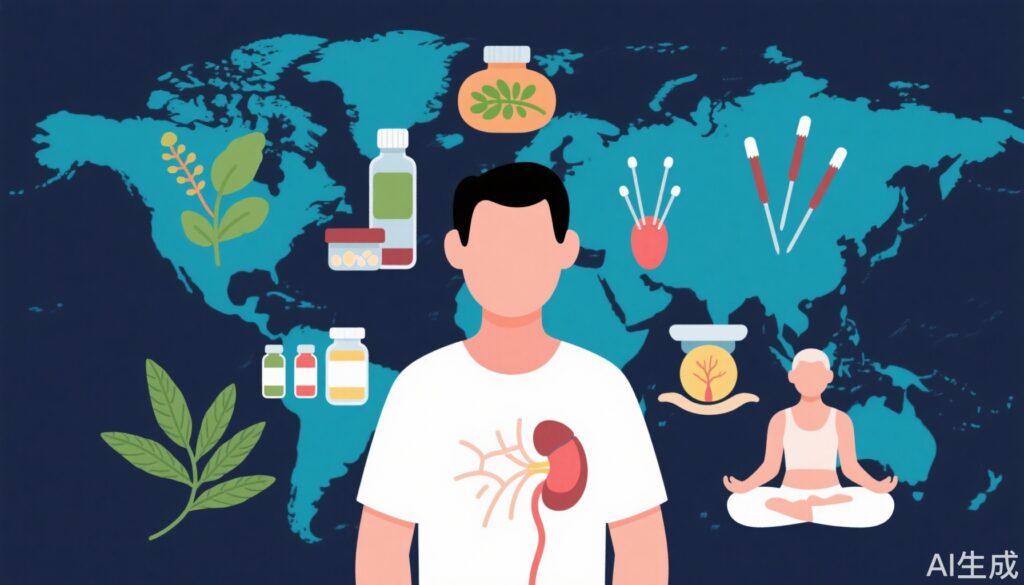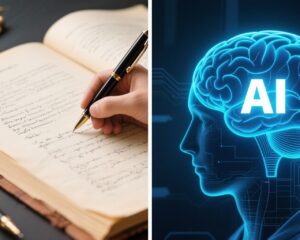Highlights
- Globally, 43% of adults with CKD use complementary and alternative medicine (CAM), with nutritional supplements being the most common modality.
- Mind-body interventions such as music therapy, meditation, relaxation, and massage demonstrate efficacy in improving anxiety, symptoms burden, and quality of life among CKD and hemodialysis patients.
- Factors positively associated with CAM use include older age, female gender, higher income, presence of hemodialysis, absence of diabetes, and positive attitudes towards CAM.
- Non-disclosure of CAM use occurs in approximately two-thirds of CKD patients, highlighting the importance of open clinician-patient communication to ensure safety and rational use.
Background
Chronic kidney disease (CKD) affects millions globally and presents complex clinical challenges, including comorbidities, symptoms burden, and treatment side effects. The limitations of conventional therapies have led many CKD patients to seek complementary and alternative medicine (CAM). CAM encompasses a broad array of approaches, including nutritional supplements, mind-body therapies, manual therapies, traditional medicines, and others. Understanding the prevalence, patterns, and determinants of CAM use in CKD is essential for clinicians to optimize patient care, ensure safety, and integrate evidence-based therapies.
Key Content
Global Prevalence and Patterns of CAM Use in CKD
A systematic review and meta-analysis by Chin et al. (2025) synthesized data from 41 studies encompassing adults at all stages of CKD and kidney replacement therapy. The pooled prevalence of CAM use was 43% (95% CI: 34%–51%), demonstrating high heterogeneity (I2 = 99.46%).
Nutritional interventions dominate the CAM landscape, with 412 different herbal and dietary supplements reported. Common supplements include various herbal preparations, vitamins, and minerals. Psychological and physical therapies such as massage, relaxation techniques, and mind-body practices (e.g., guided meditation and music therapy) also featured prominently. Other traditional modalities reported include homeopathy, traditional Chinese medicine (TCM), and Ayurvedic medicine.
Reasons for CAM usage were multifaceted, covering treatment of comorbidities, symptom relief (e.g., uremic pruritus, restless legs syndrome, hypotension, fatigue), maintenance of general health, and direct treatment of CKD.
Mind-Body and Manual Interventions: Evidence from Randomized Controlled Trials
Multiple RCTs and meta-analyses have demonstrated efficacy for mind-body interventions in CKD populations, especially among hemodialysis patients:
- Music Therapy: Systematic reviews (Li et al., 2024) and trials (Chin et al., 2025) show music therapy reduces anxiety (SMD -0.72), pain, depression, and stress in hemodialysis patients. Five-element music therapy demonstrated superior emotional benefits compared to Western music in Chinese patients undergoing maintenance hemodialysis.
- Guided Meditation and Mindfulness: Guided imagery and mindfulness meditation combined with progressive muscle relaxation significantly improve anxiety, sleep quality, exercise capacity, and quality of life in patients receiving maintenance hemodialysis (Rajabi et al., 2022; Nguyen et al., 2024).
- Massage and Aromatherapy: Aromatherapy massage with essential oils (Melissa officinalis, violet oil, olive oil) reduces anxiety, pain, pruritus severity, and skin dryness in hemodialysis patients (Yildiz et al., 2021; Eskandari et al., 2019). Massage therapy alone or combined with essential oils shows benefits for uremic pruritus and restless legs syndrome.
- Acupressure and Herbal Acupoint Therapy: RCTs found acupressure and transcutaneous electrical acupoint stimulation reduce uremic pruritus significantly. Herbal acupoint therapy (e.g., moxibustion) demonstrated efficacy in managing intradialytic hypotension and fatigue (Kurnaz et al., 2018; Ozsoy et al., 2016).
Safety and Biologic Mechanisms
Traditional Chinese medicine formula Ren Shen Yang Rong Tang showed potential in reducing chronic inflammation markers (IL-6, TNF-α) and improving serum albumin and quality of life in hemodialysis patients, although larger trials are needed (Chan et al., 2015).
Mind-body therapies likely modulate autonomic function, stress response, and inflammatory pathways, contributing to symptom relief and enhanced well-being. Herbal supplements carry variable safety profiles; clinicians must assess herb-drug interactions and monitor for adverse events.
Factors Associated with CAM Use and Disclosure Patterns
CAM use was more prevalent among older adults, females, individuals with higher incomes, those on hemodialysis, and patients with poor medication adherence. Positive attitudes and perceptions of CAM safety were influential patient-related factors.
Significantly, about 66% of CAM users did not disclose their use to healthcare providers, raising concerns about potential interactions, adverse events, and missed opportunities for integrated care.
Expert Commentary
The widespread use of CAM among CKD patients reflects unmet needs in symptom management and holistic care. Evidence supports several mind-body and manual therapies as effective adjuncts to conventional treatment, particularly for psychological symptoms and symptom burden.
However, the high heterogeneity in study designs, CAM definitions, and patient populations underscores the need for standardized research protocols and larger, well-powered RCTs. Safety concerns—especially regarding herbal supplements—necessitate vigilant clinical oversight.
Non-disclosure of CAM to providers represents a barrier to safe, comprehensive care. Healthcare professionals should proactively inquire about CAM use in a non-judgmental manner to facilitate open dialogue, detect potential risks, and incorporate beneficial CAM approaches within personalized care plans.
Guidelines from nephrology and integrative medicine organizations increasingly emphasize patient-centered approaches, including validated CAM modalities, but implementation remains inconsistent.
Conclusion
Complementary and alternative medicine is popular among individuals with chronic kidney disease globally, with nearly half utilizing CAM for multiple reasons including symptom relief and general health maintenance. Nutritional supplements, mind-body therapies, massage, and traditional medicines are commonly employed.
Robust evidence supports the efficacy of select mind-body interventions in improving quality of life and symptom burden in CKD and hemodialysis patients. Nevertheless, high prevalence of CAM non-disclosure necessitates improved clinician-patient communication to ensure safe, rational use.
Future research should focus on large-scale, well-designed RCTs, standardized CAM classification in nephrology, safety evaluation, and strategies to integrate effective CAM therapies into routine CKD management.
References
- Chin JW, Abdullah R, Tan BWW, Wong KW, Khor BH. Prevalence and patterns of complementary and alternative medicine usage among adults with chronic kidney disease: A systematic review and meta-analysis. J Integr Med. 2025 Jul;23(4):370-381. doi: 10.1016/j.joim.2025.05.001. PMID: 40436665.
- Li X, Zhang Y, Xu Y, et al. Music therapy in hemodialysis patients: Systematic review and meta-analysis. Complement Ther Med. 2024 Nov;86:103090. doi:10.1016/j.ctim.2024.103090. PMID: 39343151.
- Rajabi S, Alavi M, Hoseini F, et al. Study of effect of guided meditation on quality of life in patients of ESRD on maintenance hemodialysis – a randomized controlled trial. BMC Complement Med Ther. 2022 Sep;22(1):238. doi:10.1186/s12906-022-03717-8. PMID: 36085065.
- Eskandari P, Shahmohammadi S, Jahani S, et al. The effectiveness of Melissa officinalis L. essential oil inhalation on anxiety and symptom burden of hemodialysis patients: a randomized trial study. BMC Complement Med Ther. 2025 Mar 13;25(1):103. doi:10.1186/s12906-025-04840-y. PMID: 40082838.
- Kurnaz MM, Kart-Köseoglu H, Ceceli M, et al. Treatment of intradialytic hypotension with an herbal acupoint therapy in hemodialysis patients: A randomized pilot study. Complement Ther Med. 2018 Jun;38:67-73. doi:10.1016/j.ctim.2018.04.007. PMID: 29857882.
- Chan SW, Ho YW, Choi KC, et al. Use of traditional Chinese medicine (Ren Shen Yang Rong Tang) against microinflammation in hemodialysis patients: An open-label trial. Complement Ther Med. 2015 Jun;23(3):363-71. doi:10.1016/j.ctim.2015.03.002. PMID: 26051571.


